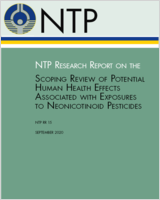This is a work of the US government and distributed under the terms of the Public Domain
NCBI Bookshelf. A service of the National Library of Medicine, National Institutes of Health.
Abstract
Introduction:
Neonicotinoid pesticides are commonly used in the United States to control insects on domestic animals and as seed coatings on agricultural crops, such as corn and soybeans. In areas of widespread use, neonicotinoids have been observed in surface waters, produce, and prepared foods. Because these pesticides are neurotoxic to insects through insect nicotinic acetylcholine receptors (nAChRs), concerns have been raised as to whether neonicotinoids may bind to receptors in off-target species, including humans, and result in adverse health effects. The associations between exposures to neonicotinoid pesticides and potential human health effects were nominated by private individuals to the National Toxicology Program (NTP) as a potential candidate for systematic review in 2014. NTP later learned that the U.S. EPA Office of Pesticide Programs (OPP) was also evaluating currently registered neonicotinoid pesticides as part of registration review activities. Thus, NTP consulted with EPA and solicited public comments during problem formulation activities to maximize the utility of this report.
Objective:
The objective of the scoping activities was to identify and summarize scientific literature indexed in PubMed reporting exposure to one or more neonicotinoid pesticides registered for use in the United States and any reported outcome relevant to human health effects.
Methods:
A scoping review was conducted following the Office of Health Assessment and Translation (OHAT) method for systematic review through an abbreviated data extraction step. A comprehensive search strategy was used to retrieve original research records from PubMed that contained reports of exposure to any of seven neonicotinoid pesticides (acetamiprid, clothianidin, imidacloprid, nitenpyram, thiacloprid, thiamethoxam, and dinotefuran) and all reported outcomes relevant to human health effects, including epidemiological, experimental animal, and in vitro model systems. Records were screened at the title-and-abstract level for relevance according to pre-specified inclusion/exclusion criteria. Included records were then screened at the full-text level to verify relevance and manually categorize studies by exposure, outcome, study type, species, and cell type, where appropriate.
Results:
A total of 191 studies were included as relevant to human health effects associated with exposure to neonicotinoid pesticides, including six epidemiological studies; 19 human case reports; and 113 experimental animal studies that included rodents, fish, Caenorhabditis elegans, and Drosophila. An interactive evidence map was prepared to allow exploration of the literature by pesticide, broad health effect categories, and evidence stream (e.g., human, animal, or in vitro). Most of the research focused on imidacloprid (n = 127 records). The most commonly reported outcome category across all evidence streams was neurological effects (n = 86), whereas congenital and developmental effects were investigated in four of the six epidemiological studies. For these health categories with the most records, the study designs including measured endpoints were captured to assess the consistency of measures for potential human health hazard evaluation.
Discussion:
In this scoping review, NTP compiled publicly available scientific literature on neonicotinoid exposure and health effects and summarized the state of the science and limitations of the evidence base of these data to support further health hazard and risk assessments. Various health effects have been reported in these data to be associated with exposure to neonicotinoids. However, a limited body of evidence was identified for use in health hazard assessment, primarily due to the heterogeneity of investigated health outcomes and measured endpoints. This scoping review by design summarizes publicly available scientific literature indexed in PubMed only and does not include any proprietary studies available to EPA, which likely contain relevant toxicological data that would complement these data and allow for more comprehensive health hazard assessment.
Contents
About the Series
- NLM CatalogRelated NLM Catalog Entries
- Review NTP Research Report on the Scoping Review of Paraquat Dichloride Exposure and Parkinson’s Disease: Research Report 16[ 2020]Review NTP Research Report on the Scoping Review of Paraquat Dichloride Exposure and Parkinson’s Disease: Research Report 16Boyd WA, Blain RB, Skuce CR, Thayer KA, Rooney AA. 2020 Sep
- Neonicotinoid pesticides: evidence of developmental neurotoxicity from regulatory rodent studies.[Front Toxicol. 2024]Neonicotinoid pesticides: evidence of developmental neurotoxicity from regulatory rodent studies.Sass JB, Donley N, Freese W. Front Toxicol. 2024; 6:1438890. Epub 2024 Oct 2.
- Review Non-acute exposure of neonicotinoids, health risk assessment, and evidence integration: a systematic review.[Crit Rev Toxicol. 2024]Review Non-acute exposure of neonicotinoids, health risk assessment, and evidence integration: a systematic review.Benchikh I, Ziani K, Gonzalez Mateos A, Khaled BM. Crit Rev Toxicol. 2024 Mar; 54(3):194-213. Epub 2024 Mar 12.
- Review NTP Research Report on the Scoping Review of Prenatal Exposure to Progestogens and Adverse Health Outcomes: Research Report 17[ 2020]Review NTP Research Report on the Scoping Review of Prenatal Exposure to Progestogens and Adverse Health Outcomes: Research Report 17National Toxicology Program. 2020 Sep
- Are encapsulated pesticides less harmful to human health than their conventional alternatives? Protocol for a systematic review of in vitro and in vivo animal model studies.[Environ Int. 2023]Are encapsulated pesticides less harmful to human health than their conventional alternatives? Protocol for a systematic review of in vitro and in vivo animal model studies.Ramadhan Makame K, Sherif M, Östlundh L, Sándor J, Ádám B, Nagy K. Environ Int. 2023 Apr; 174:107924. Epub 2023 Apr 9.
- NTP Research Report on the Scoping Review of Potential Human Health Effects Asso...NTP Research Report on the Scoping Review of Potential Human Health Effects Associated with Exposures to Neonicotinoid Pesticides
- JGI_CABC7138.fwd NIH_XGC_tropFat1 Xenopus tropicalis cDNA clone IMAGE:7803204 5'...JGI_CABC7138.fwd NIH_XGC_tropFat1 Xenopus tropicalis cDNA clone IMAGE:7803204 5', mRNA sequencegi|71456904|gnl|dbEST|30350212|gb|D 64.1|Nucleotide
- Assembly links for BioSample (Select 15687813) (1)Assembly
Your browsing activity is empty.
Activity recording is turned off.
See more...
